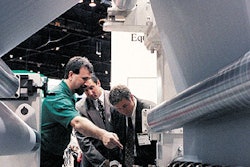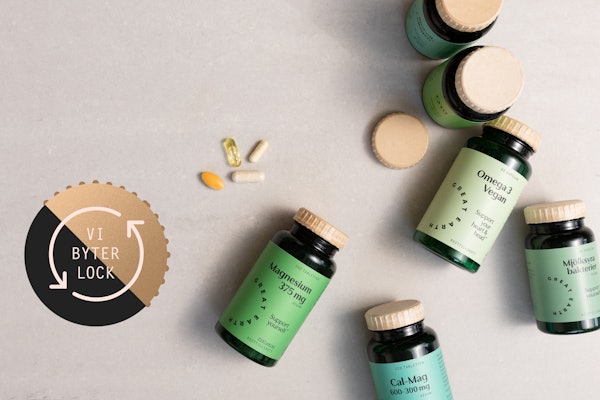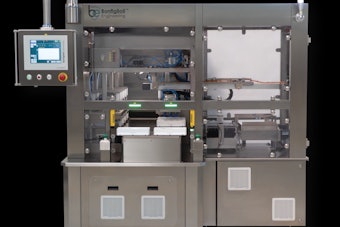It's the height of the cold and flu season, and several new pediatric and children's products hit the market in 2006. Companies are focusing their efforts on novel delivery methods, package design, licensing cartoon characters, or creating their own characters to help convey product benefits and put children at ease about taking medication.
Last June, Del Pharmaceuticals, a division of Del Laboratories Inc., Uniondale, NY, started shipping its new Orajel Kids Sore Throat Relief Strips featuring the cartoon character Scooby-Doo on the carton.
The company considered several delivery methods, says Randy Sloan, executive VP and general manager of the Del Pharmaceuticals division, and chose thin strips as a fun, easy delivery method for children. "In addition to their pain relief benefits, the strips also soothe and coat as they dissolve and slide down the back of the throat," he says. The product is packaged in a cassette with 20 strips, similar to Listerine PocketPaks, explains Sloan. The cassette is then packaged in a foil pouch to maintain freshness and protect the product.
When it came time to choose the right cartoon character for the product, Del considered the popularity and visibility of a wide range of characters. The company wanted one that was well-known and memorable, and Scooby-Doo fit the bill. "The product is targeted to kids ages 3 to 10," says Sloan. "When kids are around four, they start to have a say in the kinds of products they take. We thought using a well-known character that's trusted and well- liked by kids would enhance the experience even more."
Who's buying?
Although children often pressure their parents to buy medication featuring their favorite cartoons, drug companies realize that mom and dad have the final say. Therefore, choosing a cartoon that parents are familiar with or grew up with themselves can help make a sale when children's pleading and whining goes unnoticed.
Del Labs had parents in mind when it chose Scooby-Doo, a character that has been around for generations.
Likewise, Vivacity Products Group, Inc., Broadview, IL, chose Care Bears to adorn the packaging of its ReVital oral electrolyte product line, signing a three-year licensing agreement with American Greetings.
"The characters connect strongly with a new generation of moms that grew up with Care Bears," says Zoli Orban, president & CEO, Vivacity Products Group, Inc.. "The caring and sharing message of Care Bears resides well with parents and builds on our health-related messaging," he explains. "The Care Bears license also promotes child acceptance by making ReVital products more appealing."
Orban suggests picking a character identifiable with both parents and children. "Ideally, the imagery of the licensed character should support the product direction or brand," he says.
Co-branding
To further strike a balance between Vivacity Products Group, Inc.‚ ReVital brand and the licensed Care Bears brand, the company is in the process of finalizing a package redesign for its pediatric electrolyte products, which were scheduled to debut early this year.
"To differentiate ReVital from the competition the carton needs to effectively communicate product information to the parent making the purchasing decision and create awareness as to the character and child-friendly forms," says Orban.
"The new design places essential product information in a more prominent position, toward the top of the carton, to address caregivers' concerns. This information replaces the large Care Bears character and rainbow featured at the top of the existing carton. The redesign transfers the Care Bears characters to a more prominent position on the internal packaging while relegating the ReVital brand to a lesser role on the primary package. "The child is interacting directly with the product," explains Orban, "so we wanted to create the best experience for the child at that point in time [once the carton has been opened]."
While other types of product packaging may bear the same licensed character that the pharmaceutical company is pursuing, this should not pose concerns for either the company or the licensor. The licensor will look at whether or not the product competes directly with other products in the same category.
Licensing your character
Once the company has chosen the cartoon character most appropriate for its product, the next step is to approach the licensor of that cartoon. In the case of Scooby-Doo Sore Throat Releif strips, Del Pharmaceuticals approached Warner Brothers and submitted its product idea.
Licensors can be very protective of their brands, says Sloan, so the benefits of the products and whether or not it's a good fit with the cartoon character's image are important considerations. "Warner Brothers had to make sure they were comfortable with the product and the formulation and that they were consistent with the image they wanted for Scooby-Doo," says Sloan.
In most cases, the licensor has a style guide that the pharmaceutical company must adhere to, and companies work closely with the licensor's creative team to ensure certain parameters are met. Sloan declined to comment on specific restrictions of the Scooby-Doo license.
According to Orban, some licensors set definitive creative parameters while others are more flexible. But either way, the company gives up some creative control of the package design. "It's not so finite that you don't have choices," he says. "But there are distinct parameters you have to work through. Their creative team may want to relocate a particular callout or design element. Then you work through the process until there's mutual approval."
Typically, royalty fees are a small percentage of product sales and can vary by licensor, Orban says. Popularity and retail sales performance of the character can influence the royalty structure. Some licensors may request a financial guarantee or promo-tional expenditure in the contract.
Restrictions in relation to the character itself—size, placement, and number of times it can appear on the package—are in many cases predefined, says Orban. "Some licensing organizations will not allow you to mix your product so closely to make it appear as if the character is using the actual product," he explains.
To maximize the partnership, Orban advises companies to research the creative parameters and marketing strategy for any character prior to selecting a licensor. "When the product direction of the brand is in sync with the creative team behind the license," he says, "that's when you have a strong packaging message."
Last June, Del Pharmaceuticals, a division of Del Laboratories Inc., Uniondale, NY, started shipping its new Orajel Kids Sore Throat Relief Strips featuring the cartoon character Scooby-Doo on the carton.
The company considered several delivery methods, says Randy Sloan, executive VP and general manager of the Del Pharmaceuticals division, and chose thin strips as a fun, easy delivery method for children. "In addition to their pain relief benefits, the strips also soothe and coat as they dissolve and slide down the back of the throat," he says. The product is packaged in a cassette with 20 strips, similar to Listerine PocketPaks, explains Sloan. The cassette is then packaged in a foil pouch to maintain freshness and protect the product.
When it came time to choose the right cartoon character for the product, Del considered the popularity and visibility of a wide range of characters. The company wanted one that was well-known and memorable, and Scooby-Doo fit the bill. "The product is targeted to kids ages 3 to 10," says Sloan. "When kids are around four, they start to have a say in the kinds of products they take. We thought using a well-known character that's trusted and well- liked by kids would enhance the experience even more."
Who's buying?
Although children often pressure their parents to buy medication featuring their favorite cartoons, drug companies realize that mom and dad have the final say. Therefore, choosing a cartoon that parents are familiar with or grew up with themselves can help make a sale when children's pleading and whining goes unnoticed.
Del Labs had parents in mind when it chose Scooby-Doo, a character that has been around for generations.
Likewise, Vivacity Products Group, Inc., Broadview, IL, chose Care Bears to adorn the packaging of its ReVital oral electrolyte product line, signing a three-year licensing agreement with American Greetings.
"The characters connect strongly with a new generation of moms that grew up with Care Bears," says Zoli Orban, president & CEO, Vivacity Products Group, Inc.. "The caring and sharing message of Care Bears resides well with parents and builds on our health-related messaging," he explains. "The Care Bears license also promotes child acceptance by making ReVital products more appealing."
Orban suggests picking a character identifiable with both parents and children. "Ideally, the imagery of the licensed character should support the product direction or brand," he says.
Co-branding
To further strike a balance between Vivacity Products Group, Inc.‚ ReVital brand and the licensed Care Bears brand, the company is in the process of finalizing a package redesign for its pediatric electrolyte products, which were scheduled to debut early this year.
"To differentiate ReVital from the competition the carton needs to effectively communicate product information to the parent making the purchasing decision and create awareness as to the character and child-friendly forms," says Orban.
"The new design places essential product information in a more prominent position, toward the top of the carton, to address caregivers' concerns. This information replaces the large Care Bears character and rainbow featured at the top of the existing carton. The redesign transfers the Care Bears characters to a more prominent position on the internal packaging while relegating the ReVital brand to a lesser role on the primary package. "The child is interacting directly with the product," explains Orban, "so we wanted to create the best experience for the child at that point in time [once the carton has been opened]."
While other types of product packaging may bear the same licensed character that the pharmaceutical company is pursuing, this should not pose concerns for either the company or the licensor. The licensor will look at whether or not the product competes directly with other products in the same category.
Licensing your character
Once the company has chosen the cartoon character most appropriate for its product, the next step is to approach the licensor of that cartoon. In the case of Scooby-Doo Sore Throat Releif strips, Del Pharmaceuticals approached Warner Brothers and submitted its product idea.
Licensors can be very protective of their brands, says Sloan, so the benefits of the products and whether or not it's a good fit with the cartoon character's image are important considerations. "Warner Brothers had to make sure they were comfortable with the product and the formulation and that they were consistent with the image they wanted for Scooby-Doo," says Sloan.
In most cases, the licensor has a style guide that the pharmaceutical company must adhere to, and companies work closely with the licensor's creative team to ensure certain parameters are met. Sloan declined to comment on specific restrictions of the Scooby-Doo license.
According to Orban, some licensors set definitive creative parameters while others are more flexible. But either way, the company gives up some creative control of the package design. "It's not so finite that you don't have choices," he says. "But there are distinct parameters you have to work through. Their creative team may want to relocate a particular callout or design element. Then you work through the process until there's mutual approval."
Typically, royalty fees are a small percentage of product sales and can vary by licensor, Orban says. Popularity and retail sales performance of the character can influence the royalty structure. Some licensors may request a financial guarantee or promo-tional expenditure in the contract.
Restrictions in relation to the character itself—size, placement, and number of times it can appear on the package—are in many cases predefined, says Orban. "Some licensing organizations will not allow you to mix your product so closely to make it appear as if the character is using the actual product," he explains.
To maximize the partnership, Orban advises companies to research the creative parameters and marketing strategy for any character prior to selecting a licensor. "When the product direction of the brand is in sync with the creative team behind the license," he says, "that's when you have a strong packaging message."



















